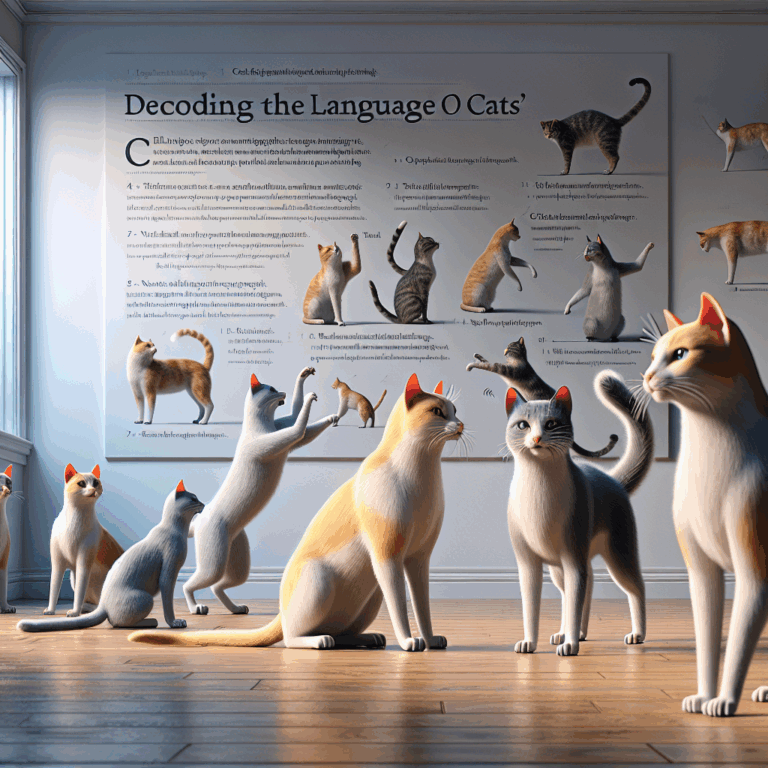Feline Communication: Decoding the Language of Cats
- No Comments
For centuries, cats have been revered as mysterious and enigmatic creatures, captivating the human imagination with their aloof charm and seemingly inscrutable behavior. Although they have been domesticated for thousands of years, the communication methods of cats remain a subject of fascination and study. Recent research has begun to unravel the complexities of feline communication, offering insights into how these solitary hunters express themselves and interact with their human companions and each other.
Unlike dogs, which have been bred for specific tasks and have evolved to communicate closely with humans, cats retain much of their wild instincts. Their communication repertoire is rich and nuanced, encompassing a variety of vocalizations, body language, and scents. While many people are familiar with the iconic “meow,” few realize that cats primarily use this vocalization to converse with humans, rather than with fellow felines. Each cat may develop its own distinct meow, tailored to elicit specific responses from its owner, whether it be for food, attention, or simply a greeting.
Beyond vocalizations, body language plays a significant role in feline communication. A cat’s tail, for instance, is a dynamic tool for expressing emotions and intentions. A raised tail often signifies confidence and friendliness, while a bristled or puffed-up tail indicates fear or aggression. The subtle flicking of the tail tip can suggest annoyance or impatience, whereas a gentle curl around the owner’s leg is a sign of affection and trust.
Cats also use their eyes to convey messages. The slow blink, often referred to as a “cat kiss,” is a gesture of trust and comfort, indicating that the cat feels safe in its environment. Conversely, direct staring can be perceived as a challenge or threat, especially among unfamiliar cats. The positioning of the ears provides further context, with forward-facing ears showing interest or curiosity, while flattened ears signal fear or aggression.
Scent communication is another critical component of how cats interact with the world around them. Cats possess scent glands in various parts of their bodies, including the face, paws, and tail. When a cat rubs its head against an object or person, it is marking its territory with pheromones, creating a familiar and comforting environment. Scratching surfaces serves a similar purpose, releasing scent markers that delineate their domain.
Understanding feline communication requires patience and observation, as each cat’s personality and preferences will influence how it chooses to interact. By paying attention to these cues, cat owners can foster a deeper bond with their pets, enhancing their mutual understanding and coexistence.
As researchers continue to delve into the intricacies of feline communication, one thing remains clear: cats, with their unique blend of independence and companionship, will always keep us guessing, ensuring that they remain as captivating and mysterious as ever.

For centuries, cats have been revered as mysterious and enigmatic creatures, captivating the human imagination with their aloof charm and seemingly inscrutable behavior. Although they have been domesticated for thousands of years, the communication methods of cats remain a subject of fascination and study. Recent research has begun to unravel the complexities of feline communication, offering insights into how these solitary hunters express themselves and interact with their human companions and each other.
Unlike dogs, which have been bred for specific tasks and have evolved to communicate closely with humans, cats retain much of their wild instincts. Their communication repertoire is rich and nuanced, encompassing a variety of vocalizations, body language, and scents. While many people are familiar with the iconic “meow,” few realize that cats primarily use this vocalization to converse with humans, rather than with fellow felines. Each cat may develop its own distinct meow, tailored to elicit specific responses from its owner, whether it be for food, attention, or simply a greeting.
Beyond vocalizations, body language plays a significant role in feline communication. A cat’s tail, for instance, is a dynamic tool for expressing emotions and intentions. A raised tail often signifies confidence and friendliness, while a bristled or puffed-up tail indicates fear or aggression. The subtle flicking of the tail tip can suggest annoyance or impatience, whereas a gentle curl around the owner’s leg is a sign of affection and trust.
Cats also use their eyes to convey messages. The slow blink, often referred to as a “cat kiss,” is a gesture of trust and comfort, indicating that the cat feels safe in its environment. Conversely, direct staring can be perceived as a challenge or threat, especially among unfamiliar cats. The positioning of the ears provides further context, with forward-facing ears showing interest or curiosity, while flattened ears signal fear or aggression.
Scent communication is another critical component of how cats interact with the world around them. Cats possess scent glands in various parts of their bodies, including the face, paws, and tail. When a cat rubs its head against an object or person, it is marking its territory with pheromones, creating a familiar and comforting environment. Scratching surfaces serves a similar purpose, releasing scent markers that delineate their domain.
Understanding feline communication requires patience and observation, as each cat’s personality and preferences will influence how it chooses to interact. By paying attention to these cues, cat owners can foster a deeper bond with their pets, enhancing their mutual understanding and coexistence.
As researchers continue to delve into the intricacies of feline communication, one thing remains clear: cats, with their unique blend of independence and companionship, will always keep us guessing, ensuring that they remain as captivating and mysterious as ever.


